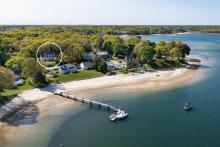The revival of the survivor bird: Marion residents learn about osprey
MARION — From cell phone towers to floating buoys, ospreys don’t shy away from man-made structures when choosing a spot to build their nests.
According to associate of the Cornell Lab of Ornithology and editor of the Birds of North America Alan Poole, the osprey’s ability to adapt to the environment around them is only one of the reasons why ospreys are known as “the survivors of our era.”
The Marion Natural History Museum was packed with Marion residents interested in learning about the “global raptor” during Poole’s lecture on Thursday, Aug. 17.
The lecture organized by both the Marion Natural History Museum and the Sippican Lands Trust explained how the osprey population has grown across the South Coast since the 1970s.
According to Poole, there were fewer than 100 pairs of ospreys living along the coastline between New York and Massachusetts in 1970. But today, there are “a hundred pairs of ospreys in Falmouth, Massachusetts alone.”
Poole said that the excessive use of pesticides lowered the survival rates of young osprey by thinning egg shells.
Over the years, efforts made to protect osprey, such as limiting use of pesticides, have caused the population to grow according to Poole.
Creating man-made platforms near water for osprey to build their nests on and relocating young birds to areas with low osprey populations have helped to revive the osprey population in North America and Europe.
According to Poole, ospreys of North America winter in the Caribbean and South America.
“Ospreys are known for extraordinary migrations,” said Poole.
According to Poole, ospreys do not travel in flocks but instead migrate alone. Once they return in the spring they reunite with their “life partner” at their nest.
“They know the route,” said Poole.
Although ospreys living in New England have “perfected” the shore-side saltmarsh nest, ospreys also nest near lakes and rivers.
“All they need to do is be up above the water and away from predators,” said Poole.
Being the only hawk that lives on live fish according to Poole, ospreys are natural fishermen equipped with large hook-like talons to catch herring, flounder and other types of fish.
According to Alan Harris of the Sippican Lands Trust, there are several man-made platforms created for osprey nests around Marion. These platforms can be seen at Brainard Marsh, Peirson Woods, Osprey Marsh and Stuart’s Island.













